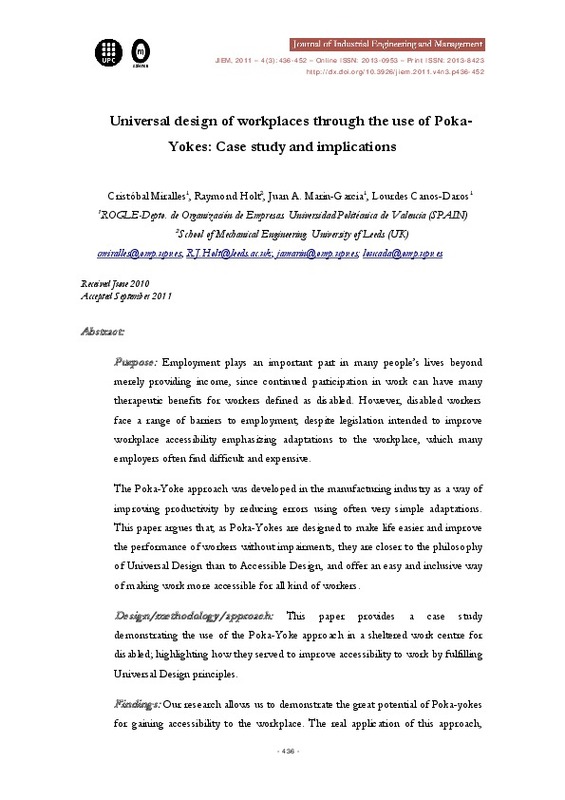JavaScript is disabled for your browser. Some features of this site may not work without it.
Buscar en RiuNet
Listar
Mi cuenta
Estadísticas
Ayuda RiuNet
Admin. UPV
Universal design of workplaces through the use of Poka-Yokes: Case study and implications
Mostrar el registro sencillo del ítem
Ficheros en el ítem
| dc.contributor.author | Miralles Insa, Cristóbal Javier
|
es_ES |
| dc.contributor.author | Holt, Raymond
|
es_ES |
| dc.contributor.author | Marín García, Juan Antonio
|
es_ES |
| dc.contributor.author | Canós Darós, Lourdes
|
es_ES |
| dc.date.accessioned | 2013-05-07T08:25:10Z | |
| dc.date.available | 2013-05-07T08:25:10Z | |
| dc.date.issued | 2011 | |
| dc.identifier.issn | 2013-8423 | |
| dc.identifier.uri | http://hdl.handle.net/10251/28612 | |
| dc.description.abstract | [EN] Purpose: Employment plays an important part in many people¿s lives beyond merely providing income, since continued participation in work can have many therapeutic benefits for workers defined as disabled. However, disabled workers face a range of barriers to employment, despite legislation intended to improve workplace accessibility emphasizing adaptations to the workplace, which many employers often find difficult and expensive. The Poka-Yoke approach was developed in the manufacturing industry as a way of improving productivity by reducing errors using often very simple adaptations. This paper argues that, as Poka-Yokes are designed to make life easier and improve the performance of workers without impairments, they are closer to the philosophy of Universal Design than to Accessible Design, and offer an easy and inclusive way of making work more accessible for all kind of workers. Design/methodology/approach: This paper provides a case study demonstrating the use of the Poka-Yoke approach in a sheltered work centre for disabled; highlighting how they served to improve accessibility to work by fulfilling Universal Design principles. Findings: Our research allows us to demonstrate the great potential of Poka-yokes for gaining accessibility to the workplace. The real application of this approach, both in sheltered work centres and ordinary companies, can contribute to improve the high unemployment rates of disabled people. Research limitations/implications: The proposal is innovative and was applied in one specific company. Thus, a range of customized Poka-yokes would be desirable for different industrial sectors. Practical implications: Managers of sheltered work centres, and also of ordinary companies, can realize about the great potential of Poka-Yokes as an easy means of gaining flexibility and accessibility. Originality/value: There are very few papers relating lean manufacturing tools and disability. Our approach analyzes the benefits of this approach for the labour integration of disabled people. | es_ES |
| dc.description.sponsorship | The authors would like to acknowledge the funding of the Research Support Program PAID-00-10 of Universitat Politècnica de València. They also would like to acknowledge the SWD involved in this research. | |
| dc.language | Inglés | es_ES |
| dc.publisher | OmniaScience | es_ES |
| dc.relation.ispartof | Journal of Industrial Engineering and Management | es_ES |
| dc.rights | Reconocimiento - No comercial (by-nc) | es_ES |
| dc.subject | Lean production | es_ES |
| dc.subject | High involvement work practices | es_ES |
| dc.subject | Sheltered work centers | es_ES |
| dc.subject.classification | ORGANIZACION DE EMPRESAS | es_ES |
| dc.title | Universal design of workplaces through the use of Poka-Yokes: Case study and implications | es_ES |
| dc.type | Artículo | es_ES |
| dc.identifier.doi | 10.3926/jiem.2011.v4n3.p436-452 | |
| dc.relation.projectID | info:eu-repo/grantAgreement/UPV//PAID-00-10/ | es_ES |
| dc.rights.accessRights | Abierto | es_ES |
| dc.contributor.affiliation | Universitat Politècnica de València. Departamento de Organización de Empresas - Departament d'Organització d'Empreses | es_ES |
| dc.description.bibliographicCitation | Miralles Insa, CJ.; Holt, R.; Marín García, JA.; Canós Darós, L. (2011). Universal design of workplaces through the use of Poka-Yokes: Case study and implications. Journal of Industrial Engineering and Management. 4(3):436-452. https://doi.org/10.3926/jiem.2011.v4n3.p436-452 | es_ES |
| dc.description.accrualMethod | S | es_ES |
| dc.relation.publisherversion | http//dx.doi.org/10.3926/jiem.2011.v4n3.p436-452 | es_ES |
| dc.description.upvformatpinicio | 436 | es_ES |
| dc.description.upvformatpfin | 452 | es_ES |
| dc.type.version | info:eu-repo/semantics/publishedVersion | es_ES |
| dc.description.volume | 4 | es_ES |
| dc.description.issue | 3 | es_ES |
| dc.relation.senia | 212597 | |
| dc.identifier.eissn | 2013-0953 | |
| dc.contributor.funder | Universitat Politècnica de València |








